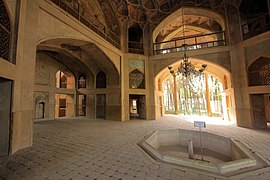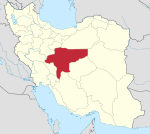| Hasht Behesht | |
|---|---|
 | |
|
| |
| General information | |
| Architectural style | Iranian |
| Location | Isfahan, Iran |
| Coordinates | 32°39′12″N 51°40′13″E / 32.6534°N 51.6702°E |
Hasht Behesht or Hasht-Behesht (هشتبهشت, also romanized as Hašt-Behešt, lit. 'the Eight Heavens') is a 17th-century pavilion in Isfahan, Iran. It was built by order of Suleiman I, the eighth shah of Iran's Safavid Empire, and functioned mainly as a private pavilion. [1] It is located in Isfahan's famous Charbagh Street. It was also the first modern school in Isfahan was called His Majesty's School (Madrese Homayouni). [2] [3]
Structure

As indicated on its name, the two-story pavilion of Hasht Behesht was built on the hasht-behesht plan, that is a type of floor plan consisting of a central hall surrounded by eight rooms. [4] The building is of an octagonal shape, [4] and has two main entrances. Four larger sides of it feature large balconies ( iwans), under which some tall and thin wooden columns are raised.
The pavilion is decorated with mural paintings, perforated woodwork, prismatic mirrors, tilework, and plasterwork. [1] [5]
Gallery
-
An 1840 drawing of Hasht Behesht by French artist Pascal Coste
-
Hasht Behesht seen from behind the pool
-
A room inside Hasht Behesht
-
Interior of a ceiling in Hasht Behesht
-
Interior of a ceiling in Hasht Behesht
-
Interior of a ceiling in Hasht Behesht
-
Interior of a ceiling in Hasht Behesht
-
An exterior view of Hasht Behesht
-
Hasht Behesht at night
See also
References
- ^ a b Babaie, Sussan; Haug, Robert (April 5, 2012). "Isfahan x. Monuments (2) Palaces". Encyclopædia Iranica. Vol. XIV. pp. 14–20. Archived from the original on May 26, 2020. Retrieved November 3, 2020.
- ^ "آنچه باید درباره مدارس نوین شهر اصفهان بدانیم - ایسنا". 2019-10-13. Archived from the original on 2019-10-13. Retrieved 2020-11-04.
- ^ "مدارس نوين در اصفهان از آغاز تا امروز (1)". rasekhoon.net. Retrieved 2020-11-04.
- ^ a b Bernardini, Michele (March 20, 2012). "HAŠT BEHEŠT (2)". Encyclopædia Iranica. Vol. XII. pp. 49–51. Archived from the original on January 7, 2019. Retrieved November 3, 2020.
- ^ "Hasht Behesht Palace". Lonely Planet. Archived from the original on 15 October 2018. Retrieved 15 October 2018.
Bibliography
- Wilber, D. N. (1962). Persian Gardens and Garden Pavilions. Tokyo. pp. 107–11.
{{ cite book}}: CS1 maint: location missing publisher ( link) - Ferrante, M. (1968). "Le Pavillon de Hašt Bihišt, ou les Huit Paradis, à Ispahan: Relevés et problèmes s'y rattachant'". In Zander, G. (ed.). Travaux de restauration de monuments historiques en Iran. Rome. pp. 399–420.
{{ cite book}}: CS1 maint: location missing publisher ( link)
| Hasht Behesht | |
|---|---|
 | |
|
| |
| General information | |
| Architectural style | Iranian |
| Location | Isfahan, Iran |
| Coordinates | 32°39′12″N 51°40′13″E / 32.6534°N 51.6702°E |
Hasht Behesht or Hasht-Behesht (هشتبهشت, also romanized as Hašt-Behešt, lit. 'the Eight Heavens') is a 17th-century pavilion in Isfahan, Iran. It was built by order of Suleiman I, the eighth shah of Iran's Safavid Empire, and functioned mainly as a private pavilion. [1] It is located in Isfahan's famous Charbagh Street. It was also the first modern school in Isfahan was called His Majesty's School (Madrese Homayouni). [2] [3]
Structure

As indicated on its name, the two-story pavilion of Hasht Behesht was built on the hasht-behesht plan, that is a type of floor plan consisting of a central hall surrounded by eight rooms. [4] The building is of an octagonal shape, [4] and has two main entrances. Four larger sides of it feature large balconies ( iwans), under which some tall and thin wooden columns are raised.
The pavilion is decorated with mural paintings, perforated woodwork, prismatic mirrors, tilework, and plasterwork. [1] [5]
Gallery
-
An 1840 drawing of Hasht Behesht by French artist Pascal Coste
-
Hasht Behesht seen from behind the pool
-
A room inside Hasht Behesht
-
Interior of a ceiling in Hasht Behesht
-
Interior of a ceiling in Hasht Behesht
-
Interior of a ceiling in Hasht Behesht
-
Interior of a ceiling in Hasht Behesht
-
An exterior view of Hasht Behesht
-
Hasht Behesht at night
See also
References
- ^ a b Babaie, Sussan; Haug, Robert (April 5, 2012). "Isfahan x. Monuments (2) Palaces". Encyclopædia Iranica. Vol. XIV. pp. 14–20. Archived from the original on May 26, 2020. Retrieved November 3, 2020.
- ^ "آنچه باید درباره مدارس نوین شهر اصفهان بدانیم - ایسنا". 2019-10-13. Archived from the original on 2019-10-13. Retrieved 2020-11-04.
- ^ "مدارس نوين در اصفهان از آغاز تا امروز (1)". rasekhoon.net. Retrieved 2020-11-04.
- ^ a b Bernardini, Michele (March 20, 2012). "HAŠT BEHEŠT (2)". Encyclopædia Iranica. Vol. XII. pp. 49–51. Archived from the original on January 7, 2019. Retrieved November 3, 2020.
- ^ "Hasht Behesht Palace". Lonely Planet. Archived from the original on 15 October 2018. Retrieved 15 October 2018.
Bibliography
- Wilber, D. N. (1962). Persian Gardens and Garden Pavilions. Tokyo. pp. 107–11.
{{ cite book}}: CS1 maint: location missing publisher ( link) - Ferrante, M. (1968). "Le Pavillon de Hašt Bihišt, ou les Huit Paradis, à Ispahan: Relevés et problèmes s'y rattachant'". In Zander, G. (ed.). Travaux de restauration de monuments historiques en Iran. Rome. pp. 399–420.
{{ cite book}}: CS1 maint: location missing publisher ( link)










